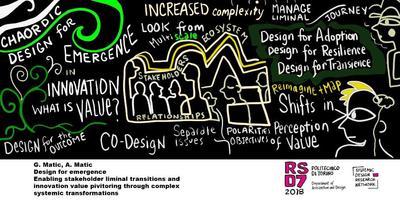Design for emergence – Enabling stakeholder liminal transitions and innovation value pivoting through complex systemic transformations
Matic, Goran and Matic, Ana (2018) Design for emergence – Enabling stakeholder liminal transitions and innovation value pivoting through complex systemic transformations. In: Proceedings of RSD7, Relating Systems Thinking and Design 7, 23-26 Oct 2018, Turin, Italy.
Preview |
Text
Matic_Emergence_2018.pdf Download (1MB) | Preview |
Preview |
Text
Matic_Slides_2018.pdf Download (389kB) | Preview |
![Matic_MM_2018.jpg [thumbnail of Matic_MM_2018.jpg]](https://openresearch.ocadu.ca/2749/3.hassmallThumbnailVersion/Matic_MM_2018.jpg)  Preview |
Image
Matic_MM_2018.jpg Download (122kB) | Preview |
Abstract
How might we emerge sustainable innovation value within complex systemic transformations?
Researchers observe that “innovation occurs through the combination and recombination of information and knowledge that are old and new” where “innovation is thus an emergent process” (Cooke, 2013). However, emerging innovation in a sustainable manner – whether within markets, communities or organizations – is increasingly viewed as being related to the processes of learning (Harkema, 2003) within complex–adaptive systems (Carlisle & McMillan, 2006), collaboration within multi–stakeholder environments (Sørensen & Torfing, 2011), and value co–creation (Romero & Molina, 2011).
And yet, the innovation initiatives entrusted with emerging sustainable innovation value frequently experience challenges in cross–industry settings – including lack of adoption by the key stakeholders in the natural resource management practices (Shiferaw, Okello, & Reddy, 2009), healthcare organizations (Cresswell & Sheikh, 2013), and policy environments (Douthwaite, Keatinge, & Park, 2001). Innovation is posited to be further complexified by the team climate and performance (González-Romá, Fortes-Ferreira, & Peiró, 2009), and the multi– dimensional aspects of enabling adoption (Pichlak, 2016).
To respond to the outlined concerns around the feasibility of emerging new value through innovation processes, we introduce Design for Emergence – a practical, applied design methodology intended for multidisciplinary teams and practitioners – to enable flourishing futures and increased resilience across systemic scales (Bergström & Dekker, 2014), human psychosocial contexts (Matin & Taylor, 2015) and social support systems (Sippel et al., 2015; Almedom, 2015). We introduce tools and methods for building social coherence (Antonovsky, 1987; Keyes 1998) across systemic scales and levels of analysis (Marr, 1982), with the goal of easing the stressors within ‘liminal spaces’ (Van Gennep, 1906; Turner, 1987) to impact desirable future outcomes and enable individual and organizational transformational journeys.
The Design for Emergence is positioned as a meta–design modality comprised of three core components: 1) Design for Adoption, 2) Design for Resilience, and 3) Design for Transience. Each component is a general purpose meta–design modality with specific canvasses, intended to simplify practical use of theoretical concepts within diverse, complex innovation environments requiring multi–stakeholder collaboration and delivery of broad cross–scale impacts.
Recognizing that the intrinsic and continued participation of key stakeholders is essential for the success of innovation initiatives, as exemplified in co–innovation (Lee, Olson, & Trimi, 2012), the Design for Adoption eases this process by leveraging motivational theory to support both initial and ongoing stakeholder engagements (Pink, 2009).
To maintain energy throughout the implementation phase of an innovation initiative, the Design for Resilience leverages methods for managing liminal journeys (Van Gennep, 1906; Turner, 1987), and uses the ‘Sense of Coherence’ (SoC) mechanism (Antonovsky, 1987; Keyes 1998) to enhance resilience of the communities, organizations and stakeholders involved.
As an innovation initiative nears completion, researchers observe that a change in the underlying value perceptions acts as a stressor (Cullen, Edwards, Casper, & Gue, 2014). To re–imagine the value propositions within the enclosing ecosystem and re–orient stakeholder value–perceptions, the Design for Transience maps how value perceptions change through the levels of analysis (Marr & Poggio, 1982), and leverages the ‘three horizons’ foresight method (Curry & Hodgson, 2008) for exploring the evolution of value perceptions from the experienced present to a perceived future.
A key objective is to be able to leverage practical tools to pivot value perceptions within market changes and complex ecosystemic transformations – to articulate value–propositions that enhance collaborative potential and create alignment with the key stakeholders, customers and communities in a way capable of enabling emergent innovation.
| Item Type: | Conference/Workshop Item (Paper) |
|---|---|
| Uncontrolled Keywords: | Innovation adoption, Social systems, Stakeholder resilience, Salutogenesis, Collaboration |
| Divisions: | Graduate Studies > Strategic Foresight and Innovation Research Labs > sLAB (Strategic Innovation Lab) |
| Related URLs: | |
| Date Deposited: | 17 Jul 2019 16:54 |
| Last Modified: | 20 Dec 2021 16:08 |
| URI: | https://openresearch.ocadu.ca/id/eprint/2749 |
Actions (login required)
 |
Edit View |

 Tools
Tools Tools
Tools